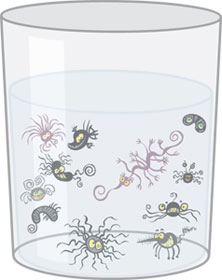
- The TRUTH About America's Water
- Water Pollutants that Cause Illness
- Are Minerals in Water Important for Health?
- Top 5 Drinking Water Contaminants
- Do I Need a Whole House Water Filter?
Coliform Bacteria and Water Quality
What are coliforms? Coliforms are bacteria that are always present in the digestive tracts of animals, including humans, and are found in their wastes. They are also found in plant and soil materials. The most basic test for bacterial contamination of a water supply is the test for total coliform bacteria. Total coliform counts give a general indication of the sanitary condition of a water supply.
Here's a look at coliforms in general:
- Total coliforms include bacteria that are found in the soil, in water that has been influenced by surface water, and inhuman or animal waste.
- Fecal coliforms are the group of the total coliforms that are considered to be present specifically in the gut and feces of warm-blooded animals. Because the origins of fecal coliforms are more specific than the origins of the more general total coliform group of bacteria, fecal coliforms are considered a more accurate indication of animal or human waste than the total coliforms.
- Escherichia coli (E. coli) is the major species in the fecal coliform group. Of the five general groups of bacteria that comprise the total coliforms, only E. coli is generally not found growing and reproducing in the environment. Consequently, E. coli is considered to be the species of coliform bacteria that is the best indicator of fecal pollution and the possible presence of pathogens.

Are Coliform Bacteria Harmful?
Most coliform bacteria do not cause disease. However, some rare strains of E. coli, particularly the strain 0157:H7, can cause serious illness. Recent outbreaks of disease caused by E. coli 0157:H7 have generated much public concern about this organism. E. coli 0157:H7 has been found in cattle, chickens, pigs, and sheep. Most of the reported human cases have been due to eating undercooked hamburgers. Cases of E. coli 0157:H7 caused by contaminated drinking water supplies are rare. Water pollution caused by fecal contamination is a serious problem due to the potential for contracting diseases from pathogens (disease-causing organisms). Frequently, concentrations of pathogens from fecal contamination are small, and the number of different possible pathogens is large. As a result, it is not practical to test for pathogens in every water sample collected. Instead, the presence of pathogens is determined with indirect evidence by testing for an "indicator" organism such as coliform bacteria.
Coliforms come from the same sources as pathogenic organisms. Coliforms are relatively easy to identify, are usually present in larger numbers than more dangerous pathogens, and respond to the environment, wastewater treatment, and water treatment similarly to many pathogens. As a result, testing for coliform bacteria can be a reasonable indication of whether other pathogenic bacteria are present.
Read Next: E.coli Water Contamination & Health Risks





